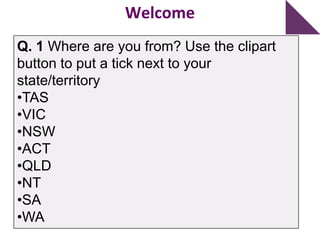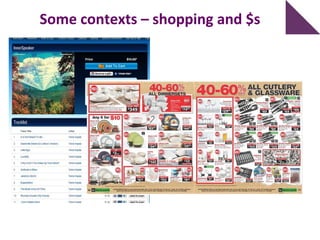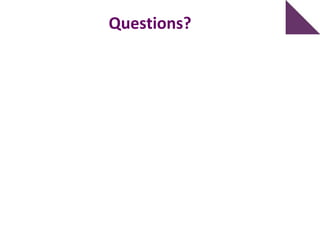Dave Tout on Numeracy
- 1. What’s the problem - teaching numeracy?Strategies for teaching Maths and NumeracyDave Tout, ACERtout@acer.edu.au
- 2. WelcomeQ. 1 Where are you from? Use the clipart button to put a tick next to your state/territoryTAS
- 3. VIC
- 4. NSW
- 5. ACT
- 6. QLD
- 7. NT
- 8. SA
- 9. WAWelcomeQ. 2 Do you (mainly) teach:LiteracyESLNumeracy?Vote by clicking on your selection.Q. 3 How many years having you been teaching adults?< 22 – 56 – 10> 10Vote by clicking on your selection.
- 10. Why is numeracy vital?
- 11. Why is numeracy vital?
- 12. Why is numeracy vital?
- 13. Why is numeracy vital?
- 14. Why is numeracy vital?The messages from the ALL surveyNumber and proportion of persons in each group with skill levels 1 or 2Numeracy scale 1,000s %Australia: 7,935.652.5Gender:47.5% of males are at levels 1 or 257.6% of females are at levels 1 or 2 A difference of over 10%!
- 15. What is numeracy?Numeracy is the bridge between mathematics and the real world
- 16. Numeracy is about making meaning of mathematics and therefore maths is seen as a critical tool to be used efficiently and effectively – and it can be low level maths through to high level maths
- 17. Numeracy is about using maths for social purposes (personal, community, work, further education)What is numeracy?Lynn A. Steen, probably the most articulate spokesperson for Quantitative Literacy/Numeracy, states that:"...numeracy is not the same as mathematics, nor is it an alternative to mathematics. Today's students need both mathematics and numeracy. Whereas mathematics asks students to rise above context, quantitative literacy is anchored in real data that reflect engagement with life's diverse contexts and situations.
- 18. Teaching numeracyTeach in context – connect to the real world – use real texts and real situations – get students to solve real problems
- 19. Use different strategies and activities – cater for different learning styles – encourage team work
- 20. Start from where students are at – allow for different levels, different interests
- 21. Scaffold and model – support the learners
- 22. Integrate with literacy teaching and activities (and assessment)
- 23. Make the maths skills explicit
- 24. Use individual, small and whole group activities
- 25. Connect language and maths – crucial
- 26. Build confidence – have fun and success!Teaching numeracy/mathematicshttp://www.bestevidence.org.uk/:The results of their review (for secondary school maths ages 12-18) show that: the most successful programmes focus on changing daily teaching practices, particularly the use of co-operative learning methods
- 27. the most successful programmes encourage student interaction.Some contexts – shopping and $s
- 28. Some contexts – sports
- 29. Some contexts – cars/driving
- 30. Some contexts – maps/directions
- 31. Some contexts – stats/dataSupermarket Customer Satisfaction
- 32. Some contexts – medicine
- 33. Numeracy counts in the workplaceAnd in workplaces they use:Measurement, including of areas and volumes
- 34. Numbers in all forms – whole, fractions, decimals, percentages
- 35. Quantities – rates, $/m, $/m3 etc
- 36. Statistics – tables, graphs, averages
- 38. And yes, they do use algebra!!What are some questions you could ask based on this text?At different ACSF levels?
- 39. What maths areas can be covered?Number and algebra?
- 41. Statistics and probability?In the classroom?Context work – applicationProjects/investigations/demonstrationsTheory, Skills & knowledgeSkills & practiceWhole & small groupSkills & practiceIndividual work
- 42. In the classroom?Fun and games – e.g. dice games (multidigit etc)
- 43. Small group work – e.g. solving problems, playing games, working together – talking, helping and sharing
- 44. Whole group work – e.g. student(s) presenting, teacher presenting/revising, playing games, group discussion, etc
- 45. Individual work - e.g. working on project, solving problems, revision, practice Fun and games
- 46. Some resourcesSee Handouts for a list of resources
- 47. Questions?
Editor's Notes
- Which team finished on top – by how much? What is the difference in points? In percentage? How do you work out the number of points? How do you work out the percentage?

























